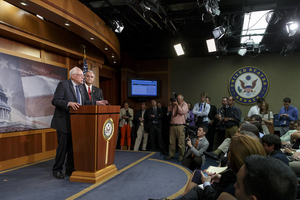VA fix 101: what the $17 billion emergency bill would do
The chairmen of the Committee on Veterans’ Affairs in the Senate and House announced an agreement Monday on a $17 billion emergency veterans bill that seeks to address a national care crisis.

Senate Veterans’ Affairs Committee Chairman Sen. Bernie Sanders, I-Vt., left, joined by House Veterans’ Affairs Committee Chairman Rep. Jeff Miller, R-Fla., speaks during a news conference on Capitol Hill, in Washington, Monday.
J. Scott Applewhite/AP
Washington
As proof that bipartisanship in Congress is still possible, a key liberal senator and his Republican counterpart in the House announced an agreement Monday on a $17 billion emergency veterans bill that last week was caught in partisan crossfire.
The bill seeks to address a national care crisis of long waits for treatment, falsified records, and reports of related deaths that led to the resignation of Veterans Affairs Secretary Eric Shinseki on May 30.
The Iraq and Afghanistan Veterans of America expressed support for the agreement, which was announced by the chairmen of the Committee on Veterans’ Affairs in the Senate and House, Sen. Bernie Sanders of Vermont, an independent who caucuses with Democrats, and Rep. Jeff Miller, (R) of Florida.
“We’re generally happy with the deal,” said Lauren Augustine, a legislative associate for the veterans group.
The compromise bill, expected to pass out of a conference committee Monday, still must be passed by the Senate and House before it can go to the president for signing. The hope is to get the bill through both chambers before Congress breaks for its long summer recess at the end of this week. Here are answers to some key questions about the bill:
Q. How does the bill shorten wait times for veterans?
A. It allows veterans who can’t get an appointment within the VA's wait-time goal, now 30 days, to go outside the VA system for care. That option also exists for those who live more than 40 miles from a VA facility. This $10 billion provision enables a sort of “surge capacity” that “promises to increase veterans’ options for timely, high-quality care,” says Katherine Kidder, research associate at the Center for a New American Security, a think tank.
On the other hand, she warns, “it outsources the VA’s responsibility and removes some of the pressure to reform.”
Q. What about the need to beef up services within the VA?
In the last four years, 2 more million veterans have entered the VA system, with a net increase of 1.5 million more patients, according to Acting VA Secretary Sloan Gibson. The legislation provides $5 billion to pay for more doctors and nurses and deal with space restrictions in crowded facilities. The VA will be allowed to lease at least 27 medical facilities to help provide access that is closer to home for many veterans, and increase the availability of specialty care.
Q. Will the bill get at records falsification that covered up long wait times?
“We have all been outraged by the manipulation of waiting-time data and by the dishonesty of some VA officials, and by the retaliation against whistle-blowers who tried to expose serious problems,” Senator Sanders said at a press conference unveiling the agreement Monday. The bill gives the VA secretary new authority to immediately remove incompetent senior executives – without pay – while also providing those who have been laid off a week to appeal, and then a 21-day review period for a decision.
Q. Who is going to be the new head of the VA?
Robert McDonald, the former CEO of Proctor & Gamble, has gotten a warm reception on the Hill and is expected to be confirmed by the Senate this week. Mr. McDonald is an Army veteran, and comes from a family of veterans. At his Senate confirmation hearing last week, he cited cultural and moral challenges at the VA, such as integrity, transparency, and accountability, in addition to the challenge of timely access to care.
“The VA is in crisis. The veterans are in need. There is a lot of work to do to transform the department and it will not be easy, but it is essential and can be achieved,” he said last week.
Q. What are the potential pitfalls with the compromise?
Spending is one. Because the long waiting times are viewed as a current emergency, the bill relies on emergency spending for funding. This could be a deal-killer among debt-conscious conservatives in the House, but a nod has been made to them by finding $5 billion in VA offsets out of the total $17 billion.
Representative Miller jokingly told reporters he comes from a sales background, and that he can deliver the sale – though it won’t be unanimous among Republicans.
Ms. Kidder says the issue is less one of funding, and much more of allocation – how money is spent and how the VA is managed. The backlog problems are occurring in a massive agency with an annual budget of more than $150 billion, she points out.
Another potential problem would be if, given the choice, veterans choose to flee the VA – like parents choose charter schools over public schools. But both chairmen cited studies that show once veterans are inside the system, they are generally pleased with it. The problem is getting timely access to the system.
Q. How did this agreement come about in such a partisan climate?
Three things worked in favor of the deal: a national crisis and scandal that called out for bipartisanship; the strong desire to address this issue before the August recess; and the very issue of caring for America’s veterans. Lawmakers may not be able to agree on immigrants, but they can usually find a way to rally around those who have sacrificed to protect the nation.
Even at last week’s low point, both senators and their staffs kept talking with each other. “We continued to communicate,” Miller said.

